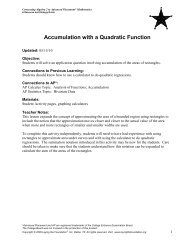18.2 Viruses, viroids, and prions are formidable pathogens in ...
18.2 Viruses, viroids, and prions are formidable pathogens in ...
18.2 Viruses, viroids, and prions are formidable pathogens in ...
You also want an ePaper? Increase the reach of your titles
YUMPU automatically turns print PDFs into web optimized ePapers that Google loves.
<strong>18.2</strong> <strong>Viruses</strong>, <strong>viroids</strong>, <strong>and</strong> <strong>prions</strong> <strong>are</strong> <strong>formidable</strong> <strong>pathogens</strong> <strong>in</strong> animals <strong>and</strong> plants<br />
Section Vocabulary Vacc<strong>in</strong>e - A harmless variant or derivative of a pathogen that stimulates a host’s immune system<br />
to mount defenses aga<strong>in</strong>st the pathogen.<br />
Viroid - A plant pathogen composed of molecules of naked circular RNA only several hundred<br />
nucleotides long.<br />
Prion - An <strong>in</strong>fectious form of prote<strong>in</strong> that may <strong>in</strong>crease <strong>in</strong> number by convert<strong>in</strong>g related prote<strong>in</strong>s<br />
to more <strong>prions</strong>.<br />
Viral Diseases <strong>in</strong> Animals The l<strong>in</strong>k between a viral <strong>in</strong>fection <strong>and</strong> the symptoms it produces is often obscure. <strong>Viruses</strong> may<br />
damage or kill cells by caus<strong>in</strong>g the release of hydrolytic enzymes from lysosomes. Some viruses<br />
cause <strong>in</strong>fected cells to produce tox<strong>in</strong>s that lead to disease symptoms, <strong>and</strong> some have molecular<br />
components that <strong>are</strong> toxic, such as envelope prote<strong>in</strong>s. How much damage a virus causes depends<br />
partly on the ability of the <strong>in</strong>fected tissue to regenerate by cell division. People usually recover<br />
completely from colds because the epithelium of the respiratory tract, which the viruses <strong>in</strong>fect,<br />
can efficiently repair itself. In contrast, damage <strong>in</strong>flicted by poliovirus to mature nerve cells is<br />
permanent, because these cells do not divide <strong>and</strong> usually cannot be replaced. Many of the<br />
temporary symptoms associated with viral <strong>in</strong>fections, such as fever <strong>and</strong> aches, actually result<br />
from the body’s own efforts at defend<strong>in</strong>g itself aga<strong>in</strong>st <strong>in</strong>fection.<br />
The immune system is a complex <strong>and</strong> critical part of the body’s natural defenses. The immune<br />
system is also the basis for the major medical tool for prevent<strong>in</strong>g viral <strong>in</strong>fections—vacc<strong>in</strong>es.<br />
Vacc<strong>in</strong>es <strong>are</strong> harmless variants or derivatives of pathogenic microbes that stimulate the immune<br />
system to mount defenses aga<strong>in</strong>st the actual pathogen. Vacc<strong>in</strong>ation has eradicated smallpox, at<br />
one time a devastat<strong>in</strong>g scourge <strong>in</strong> many parts of the world. The viruses that cause smallpox,<br />
polio, <strong>and</strong> measles <strong>in</strong>fect only humans. This very narrow host range was critical to the successful<br />
effort of the World Health Organization to eradicate smallpox; similar worldwide vacc<strong>in</strong>ation<br />
campaigns currently <strong>are</strong> under way to eradicate the other two viruses as well. Effective vacc<strong>in</strong>es<br />
<strong>are</strong> also available aga<strong>in</strong>st rubella, mumps, hepatitis B, <strong>and</strong> a number of other viral diseases.<br />
Although vacc<strong>in</strong>es can prevent certa<strong>in</strong> viral illnesses, medical technology can do little, at present,<br />
to cure most viral <strong>in</strong>fections once they occur. The antibiotics that help us recover from bacterial<br />
<strong>in</strong>fections <strong>are</strong> powerless aga<strong>in</strong>st viruses. Antibiotics kill bacteria by <strong>in</strong>hibit<strong>in</strong>g enzyme–catalyzed<br />
processes specific to the <strong>pathogens</strong>, but viruses have few or no enzymes of their own. However,<br />
a few drugs effectively combat certa<strong>in</strong> viruses. Most antiviral drugs resemble nucleosides <strong>and</strong> as<br />
a result <strong>in</strong>terfere with viral nucleic acid synthesis. One such drug is acyclovir, which impedes<br />
herpesvirus reproduction by <strong>in</strong>hibit<strong>in</strong>g the viral polymerase that synthesizes viral DNA. Similarly,<br />
azidothymid<strong>in</strong>e (AZT) curbs HIV reproduction by <strong>in</strong>terfer<strong>in</strong>g with the synthesis of DNA by reverse<br />
transcriptase. In the past ten years, much effort has gone <strong>in</strong>to develop<strong>in</strong>g drugs aga<strong>in</strong>st HIV.<br />
Currently, multidrug treatments, sometimes called “cocktails,” have been found to be most<br />
effective. Such a regimen commonly <strong>in</strong>cludes a comb<strong>in</strong>ation of two nucleoside mimics <strong>and</strong> a<br />
protease <strong>in</strong>hibitor, which <strong>in</strong>terferes with an enzyme required for assembly of virus particles.<br />
Emerg<strong>in</strong>g <strong>Viruses</strong> <strong>Viruses</strong> that appear suddenly or that suddenly come to the attention of medical scientists <strong>are</strong><br />
often referred to as emerg<strong>in</strong>g viruses. HIV, the AIDS virus, is a classic example: This virus<br />
appe<strong>are</strong>d <strong>in</strong> San Francisco <strong>in</strong> the early 1980s, seem<strong>in</strong>gly out of nowhere. The deadly Ebola virus,<br />
recognized <strong>in</strong>itially <strong>in</strong> 1976 <strong>in</strong> central Africa, is one of several emerg<strong>in</strong>g viruses that cause<br />
hemorrhagic fever, an often fatal syndrome characterized by fever, vomit<strong>in</strong>g, massive bleed<strong>in</strong>g,<br />
<strong>and</strong> circulatory system collapse. A number of other dangerous new viruses cause encephalitis,<br />
<strong>in</strong>flammation of the bra<strong>in</strong>. One example is the West Nile virus, which appe<strong>are</strong>d for the first time<br />
<strong>in</strong> North America <strong>in</strong> 1999 <strong>and</strong> has spread to all 48 contiguous states <strong>in</strong> the U.S.<br />
An even more recent viral disease to emerge is severe acute respiratory syndrome (SARS), which<br />
first appe<strong>are</strong>d <strong>in</strong> southern Ch<strong>in</strong>a <strong>in</strong> November 2002 (Figure 18.11a). Dur<strong>in</strong>g a global outbreak<br />
from November 2002 to July 2003, about 8,000 people were known to be <strong>in</strong>fected, of whom<br />
more than 700 subsequently died. Researchers quickly identified the agent caus<strong>in</strong>g SARS as a<br />
coronavirus, a virus with a s<strong>in</strong>gle–str<strong>and</strong>ed RNA genome (class IV) that was not previously known<br />
to cause disease <strong>in</strong> humans (Figure 18.11b).<br />
From where <strong>and</strong> how do such viruses burst on the human scene, giv<strong>in</strong>g rise to previously r<strong>are</strong> or<br />
unknown diseases? Three processes contribute to the emergence of viral diseases. First, the<br />
1
<strong>18.2</strong> <strong>Viruses</strong>, <strong>viroids</strong>, <strong>and</strong> <strong>prions</strong> <strong>are</strong> <strong>formidable</strong> <strong>pathogens</strong> <strong>in</strong> animals <strong>and</strong> plants<br />
mutation of exist<strong>in</strong>g viruses is a major source of these new diseases. RNA viruses tend to have an<br />
unusually high rate of mutation because errors <strong>in</strong> replicat<strong>in</strong>g their RNA genomes <strong>are</strong> not<br />
corrected by proofread<strong>in</strong>g. Some mutations enable exist<strong>in</strong>g viruses to evolve <strong>in</strong>to new genetic<br />
varieties (stra<strong>in</strong>s) that can cause disease <strong>in</strong> <strong>in</strong>dividuals who had developed immunity to the<br />
ancestral virus. Flu epidemics, for <strong>in</strong>stance, <strong>are</strong> caused by new stra<strong>in</strong>s of <strong>in</strong>fluenza virus<br />
genetically different enough from earlier stra<strong>in</strong>s that people have little immunity to them.<br />
Another source of new viral diseases is the spread of exist<strong>in</strong>g viruses from one host species to<br />
another. Scientists estimate that about three–quarters of new human diseases orig<strong>in</strong>ate <strong>in</strong> other<br />
animals. For example, hantavirus is common <strong>in</strong> rodents, especially deer mice. The population of<br />
deer mice <strong>in</strong> the southwestern United States exploded <strong>in</strong> 1993 after unusually wet weather<br />
<strong>in</strong>creased the rodents′ food supply. Many people who <strong>in</strong>haled dust conta<strong>in</strong><strong>in</strong>g traces of ur<strong>in</strong>e <strong>and</strong><br />
feces from <strong>in</strong>fected mice became <strong>in</strong>fected with hantavirus, <strong>and</strong> dozens died. The source of the<br />
SARS–caus<strong>in</strong>g virus was still undeterm<strong>in</strong>ed as of spr<strong>in</strong>g 2004, although c<strong>and</strong>idates <strong>in</strong>clude the<br />
exotic animals found <strong>in</strong> food markets <strong>in</strong> Ch<strong>in</strong>a. And early 2004 brought reports of the first cases<br />
of people <strong>in</strong> southeast Asia <strong>in</strong>fected with a flu virus previously seen only <strong>in</strong> birds. If this virus<br />
evolves so that it can spread easily from person to person, the potential for a major human<br />
outbreak is significant. Indeed, evidence is strong that the flu p<strong>and</strong>emic of 1918–1919, which<br />
killed about 40 million people, orig<strong>in</strong>ated <strong>in</strong> birds.<br />
F<strong>in</strong>ally, the dissem<strong>in</strong>ation of a viral disease from a small, isolated population can lead to<br />
widespread epidemics. For <strong>in</strong>stance, AIDS went unnamed <strong>and</strong> virtually unnoticed for decades<br />
before it began to spread around the world. In this case, technological <strong>and</strong> social factors,<br />
<strong>in</strong>clud<strong>in</strong>g affordable <strong>in</strong>ternational travel, blood transfusions, sexual promiscuity, <strong>and</strong> the abuse of<br />
<strong>in</strong>travenous drugs, allowed a previously r<strong>are</strong> human disease to become a global scourge.<br />
Thus, emerg<strong>in</strong>g viruses <strong>are</strong> generally not new; rather, they <strong>are</strong> exist<strong>in</strong>g viruses that mutate,<br />
spread to new host species, or dissem<strong>in</strong>ate more widely <strong>in</strong> the current host species. Changes <strong>in</strong><br />
host behavior or environmental changes can <strong>in</strong>crease the viral traffic responsible for emerg<strong>in</strong>g<br />
diseases. For example, new roads through remote <strong>are</strong>as can allow viruses to spread between<br />
previously isolated human populations. Another problem is the destruction of forests to exp<strong>and</strong><br />
cropl<strong>and</strong>, an environmental disturbance that br<strong>in</strong>gs humans <strong>in</strong>to contact with other animals that<br />
may host viruses capable of <strong>in</strong>fect<strong>in</strong>g humans.<br />
Viral Diseases <strong>in</strong> Plants More than 2,000 types of viral diseases of plants <strong>are</strong> known, <strong>and</strong> together they account for an<br />
estimated loss of $15 billion annually worldwide due to agricultural <strong>and</strong> horticultural crop<br />
destruction. Common symptoms of viral <strong>in</strong>fection <strong>in</strong>clude bleached or brown spots on leaves <strong>and</strong><br />
fruits, stunted growth, <strong>and</strong> damaged flowers or roots, all tend<strong>in</strong>g to dim<strong>in</strong>ish the yield <strong>and</strong><br />
quality of crops (Figure 18.12).<br />
Plant viruses have the same basic structure <strong>and</strong> mode of replication as animal viruses. Most plant<br />
viruses discovered thus far, <strong>in</strong>clud<strong>in</strong>g tobacco mosaic virus (TMV), have an RNA genome. Many<br />
have a rod–shaped capsid, like TMV (see Figure 18.4a); others have a polyhedral capsid.<br />
Plant viral diseases spread by two major routes. In the first route, called horizontal transmission,<br />
a plant is <strong>in</strong>fected from an external source of the virus. Because the <strong>in</strong>vad<strong>in</strong>g virus must get past<br />
the plant’s outer protective layer of cells (the epidermis), the plant becomes more susceptible to<br />
viral <strong>in</strong>fections if it has been damaged by w<strong>in</strong>d, <strong>in</strong>jury, or <strong>in</strong>sects. Insects pose a double threat,<br />
because they can also act as carriers of viruses, transmitt<strong>in</strong>g disease from plant to plant. Farmers<br />
<strong>and</strong> gardeners may transmit plant viruses <strong>in</strong>advertently on prun<strong>in</strong>g shears <strong>and</strong> other tools. The<br />
other route of viral <strong>in</strong>fection is vertical transmission, <strong>in</strong> which a plant <strong>in</strong>herits a viral <strong>in</strong>fection<br />
from a p<strong>are</strong>nt. Vertical transmission can occur <strong>in</strong> asexual propagation (for example, by tak<strong>in</strong>g<br />
cutt<strong>in</strong>gs) or <strong>in</strong> sexual reproduction via <strong>in</strong>fected seeds.<br />
Once a virus enters a plant cell <strong>and</strong> beg<strong>in</strong>s reproduc<strong>in</strong>g, viral components can spread throughout<br />
the plant by pass<strong>in</strong>g through plasmodesmata, the cytoplasmic connections that penetrate the<br />
walls between adjacent plant cells (see Figure 6.28). Prote<strong>in</strong>s encoded by viral genes <strong>are</strong> capable<br />
of alter<strong>in</strong>g the diameter of plasmodesmata to allow passage of viral prote<strong>in</strong>s or genomes.<br />
Scientists have not yet devised cures for most viral plant diseases. So their efforts <strong>are</strong> focused<br />
largely on reduc<strong>in</strong>g the <strong>in</strong>cidence <strong>and</strong> transmission of such diseases <strong>and</strong> on breed<strong>in</strong>g varieties of<br />
crop plants that <strong>are</strong> relatively resistant to certa<strong>in</strong> viruses.<br />
2
<strong>18.2</strong> <strong>Viruses</strong>, <strong>viroids</strong>, <strong>and</strong> <strong>prions</strong> <strong>are</strong> <strong>formidable</strong> <strong>pathogens</strong> <strong>in</strong> animals <strong>and</strong> plants<br />
Viroids <strong>and</strong> Prions: The<br />
Simplest Infectious Agents As small <strong>and</strong> simple as viruses <strong>are</strong>, they dwarf another class of <strong>pathogens</strong>: <strong>viroids</strong>. These <strong>are</strong><br />
circular RNA molecules, only several hundred nucleotides long, that <strong>in</strong>fect plants. One viroid<br />
disease has killed over 10 million coconut palms <strong>in</strong> the Philipp<strong>in</strong>es. Viroids do not encode<br />
prote<strong>in</strong>s but can replicate <strong>in</strong> host plant cells, app<strong>are</strong>ntly us<strong>in</strong>g cellular enzymes. These small RNA<br />
molecules seem to cause errors <strong>in</strong> the regulatory systems that control plant growth, <strong>and</strong> the<br />
symptoms typically associated with viroid diseases <strong>are</strong> abnormal development <strong>and</strong> stunted<br />
growth.<br />
An important lesson from <strong>viroids</strong> is that a s<strong>in</strong>gle molecule can be an <strong>in</strong>fectious agent that spreads<br />
a disease. But <strong>viroids</strong> <strong>are</strong> nucleic acid, whose ability to be replicated is well known. Even more<br />
surpris<strong>in</strong>g is the evidence for <strong>in</strong>fectious prote<strong>in</strong>s, called <strong>prions</strong>, which appear to cause a number<br />
of degenerative bra<strong>in</strong> diseases <strong>in</strong> various animal species. These diseases <strong>in</strong>clude scrapie <strong>in</strong> sheep;<br />
mad cow disease, which has plagued the European beef <strong>in</strong>dustry <strong>in</strong> recent years; <strong>and</strong><br />
Creutzfeldt–Jakob disease <strong>in</strong> humans, which has caused the death of some 125 British people <strong>in</strong><br />
the past decade. Prions <strong>are</strong> most likely transmitted <strong>in</strong> food, as <strong>in</strong> the consumption by people of<br />
prion–laden beef from cattle with mad cow disease. Two characteristics of <strong>prions</strong> <strong>are</strong> especially<br />
alarm<strong>in</strong>g. First, <strong>prions</strong> <strong>are</strong> very slow–act<strong>in</strong>g agents; the <strong>in</strong>cubation period until symptoms appear<br />
is around ten years. Second, <strong>prions</strong> <strong>are</strong> virtually <strong>in</strong>destructible; they <strong>are</strong> not destroyed or<br />
deactivated by heat<strong>in</strong>g to normal cook<strong>in</strong>g temperatures. To date, there is no known cure for<br />
prion diseases, <strong>and</strong> the only hope for develop<strong>in</strong>g effective treatments lies <strong>in</strong> underst<strong>and</strong><strong>in</strong>g the<br />
mechanism of <strong>in</strong>fection.<br />
How can a prote<strong>in</strong>, which cannot replicate itself, be a transmissible pathogen? Accord<strong>in</strong>g to the<br />
lead<strong>in</strong>g hypothesis, a prion is a misfolded form of a prote<strong>in</strong> normally present <strong>in</strong> bra<strong>in</strong> cells. When<br />
the prion gets <strong>in</strong>to a cell conta<strong>in</strong><strong>in</strong>g the normal form of the prote<strong>in</strong>, the prion converts the<br />
normal prote<strong>in</strong> to the prion version (Figure 18.13). In this way, <strong>prions</strong> may repeatedly trigger<br />
cha<strong>in</strong> reactions that <strong>in</strong>crease their numbers. This model, first proposed <strong>in</strong> the early 1980s, is now<br />
widely accepted.<br />
1. Describe two ways a preexist<strong>in</strong>g virus can become an emerg<strong>in</strong>g virus.<br />
a. Mutations can lead to a new stra<strong>in</strong> of a virus that can no longer be recognized by the immune<br />
system, even if an animal has been exposed to the orig<strong>in</strong>al stra<strong>in</strong>; a virus can jump from one<br />
species to a new host; <strong>and</strong> a r<strong>are</strong> virus can spread if a population becomes less isolated.<br />
2. Comp<strong>are</strong> horizontal versus vertical transmission of viruses <strong>in</strong> plants.<br />
a. In horizontal transmission, a plant is <strong>in</strong>fected from an external source of virus, which could enter<br />
through a break <strong>in</strong> the plant’s epidermis due to damage by <strong>in</strong>sects or other animals. In vertical<br />
transmission, a plant <strong>in</strong>herits viruses from its p<strong>are</strong>nt either via <strong>in</strong>fected seeds (sexual<br />
reproduction) or via an <strong>in</strong>fected cutt<strong>in</strong>g (asexual reproduction).<br />
3. Why does the long <strong>in</strong>cubation period of <strong>prions</strong> <strong>in</strong>crease their danger as a cause of human disease?<br />
a. A source of <strong>in</strong>fection, such as prion–<strong>in</strong>fected cattle, may show no symptoms for many years. Beef<br />
prep<strong>are</strong>d from such animals before symptoms appear would not be recognized as hazardous <strong>and</strong><br />
could transmit <strong>in</strong>fection to people who eat the meat.<br />
3








